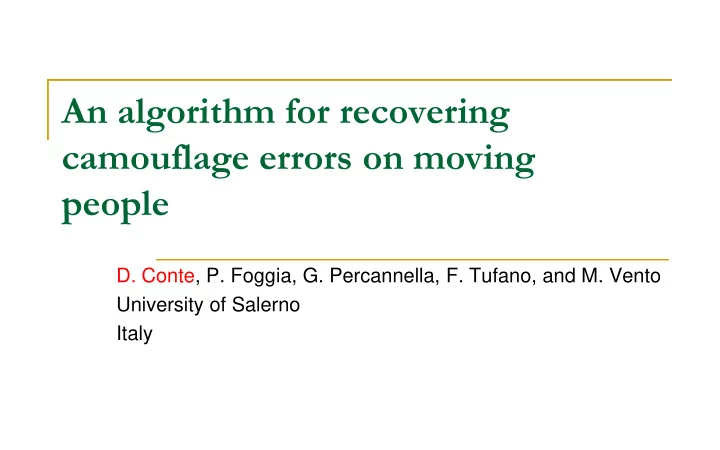

An algorithm for recovering camouflage errors on moving people D. Conte, P. Foggia, G. Percannella, F. Tufano, and M. Vento University of Salerno Italy
Outline Definition of the problem Related works The proposed algorithm Experimental results 30 August, 2010 An algorithm for recovering camouflage errors on moving people 2
Detecting Moving Objects The most popular approach: Background Subtraction - = Background Foreground Mask Current Frame Moving Objects 30 August, 2010 An algorithm for recovering camouflage errors on moving people 3
The camouflage problem 1/2 Background subtraction technique is subject to a set of well known problems, categorized in [9] One of this is the camouflage 30 August, 2010 An algorithm for recovering camouflage errors on moving people 4
The camouflage problem 2/2 The effect of camouflage consists in a (random) fragmentation of the actual object in the scene 30 August, 2010 An algorithm for recovering camouflage errors on moving people 5
Related Works Camouflage has received less attention than the other problems Some methods (e.g. [4]) involve the use of depth information to detect camouflaged objects High computation cost and impracticable with legacy cameras Other methods (e.g. [3, 8, 10]) propose some techniques to detect camouflaged objects by exploiting properties (e.g. color) of pixels belonging to a camouflaged object. A single camouflaged pixel is unrecognizable without analyze its neighborhood 30 August, 2010 An algorithm for recovering camouflage errors on moving people 6
The proposed algorithm We define a model of the desired object(s) 1. a procedure to suitably grouping obtained blobs (connected 1. components detected in the background subtraction phase) so as to adequately fit the model 30 August, 2010 An algorithm for recovering camouflage errors on moving people 7
The proposed model We focused our attention to the detection of moving people The model must be carefully defined: A too detailed model would result in many missed detection b 1 and b 2 are minimum and A too general model would cause maximum real width the generation of many false h 1 and h 2 are minimum and positive errors maximum real height 30 August, 2010 An algorithm for recovering camouflage errors on moving people 8
The grouping procedure 1/2 Objective grouping two or more blobs in order to form a unique blob representing the object defined with the model The procedure repeatedly merging couples of blobs into larger ones until the new blob best fits the defined model 30 August, 2010 An algorithm for recovering camouflage errors on moving people 9
The grouping procedure 2/2 Conditions to group two blobs (represented by their bounding boxes X and Y) right X left Y left X right Y ( ) ( ) ( ) ( ) 1. p p p p The projection on the horizontal axis of the bounding boxes are overlapped height r ( Z ) [ h 1 h , ] 2. The grouped box Z is built starting 2 The real height of the grouped box from X and Y pixels coordinates is included between ℎ 1 and ℎ 2 Inverse Perspective Mapping is width r ( Z ) [ b 1 b , ] 3. 2 applied in order to determine its real The real height of the grouped box size is included between ℎ 1 and ℎ 2 30 August, 2010 An algorithm for recovering camouflage errors on moving people 10
An Example Bounding Foreground Source image and a detail of a person Boxes Mask 30 August, 2010 An algorithm for recovering camouflage errors on moving people 11
Experimental Results 1/4 The proposed method is independent from the foreground detection algorithm used is used as a postprocessing on the output of four well known foreground detection techniques Mixture of Gaussians [5] (MOG) Enhanced Background Subtraction [2] (EBS) Self-Organizing Background Subtraction [7] (SOBS) Statistical Background Algorithm [6] (SBA) 30 August, 2010 An algorithm for recovering camouflage errors on moving people 12
Experimental Results 2/4 Performance index Fuzzy definition for True Positive, False Positive and False Negative G set of bounding boxes of the ground truth where D set of bounding boxes detected by the algorithm | · | area of a bounding box 30 August, 2010 An algorithm for recovering camouflage errors on moving people 13
Experimental Results 3/4 Dataset videos acquired in different lighting and weather conditions NA2 NA1 NA3 Public database Indoor sequence (PETS Conference) (presented in [7]) http://www.cvg.rdg.ac.uk/PETS2006/ PETS MSA 30 August, 2010 An algorithm for recovering camouflage errors on moving people 14
Experimental Results 4/4 30 August, 2010 An algorithm for recovering camouflage errors on moving people 15
Conclusions and Future Works We presented a new model-based method for removing camouflage errors in video surveillance applications Experimentations confirmed the effectiveness of the method Future improvements Refining the model Definitions of suitable models for other objects of interest 30 August, 2010 An algorithm for recovering camouflage errors on moving people 16
Recommend
More recommend